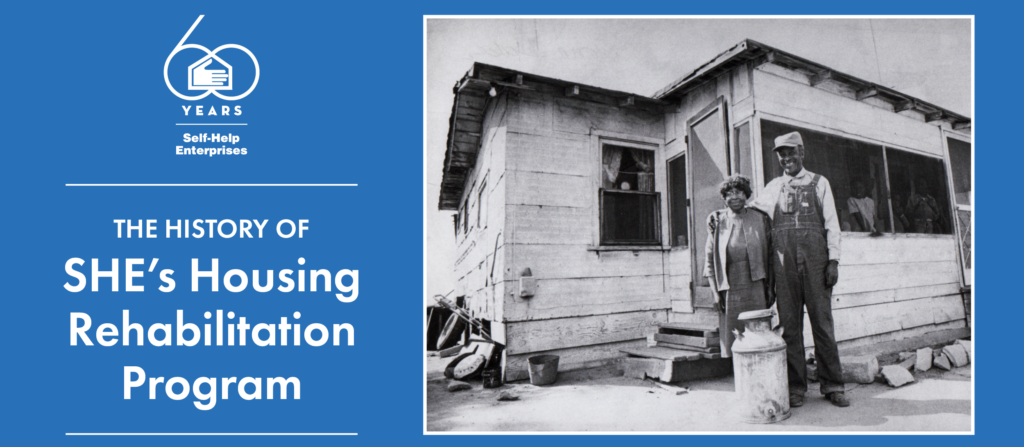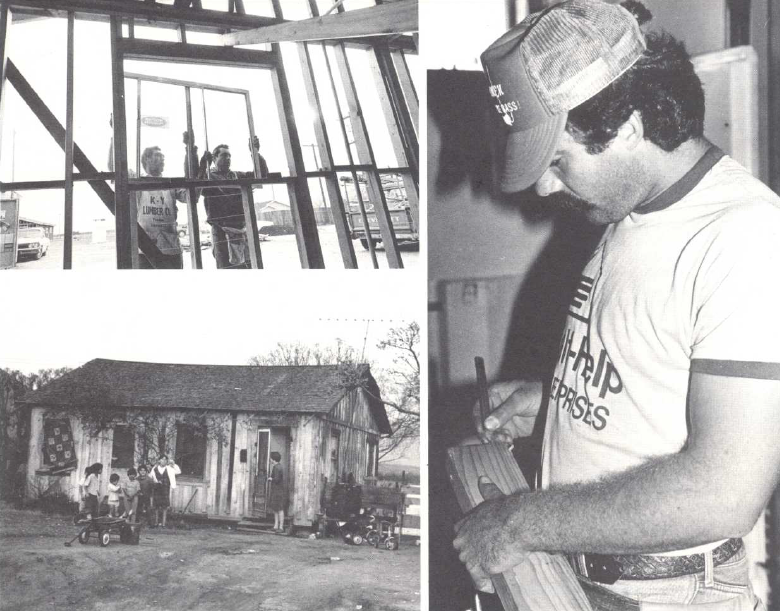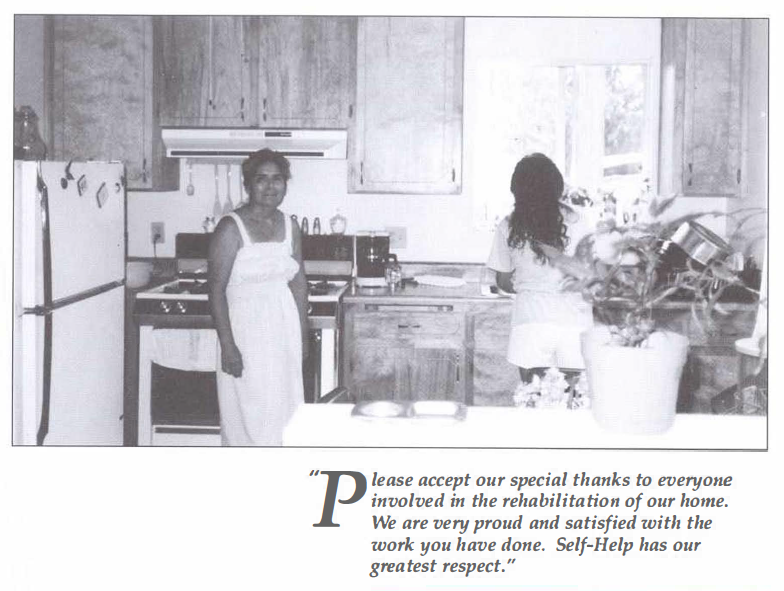The History of SHE’s Housing Rehabilitation Program
The History of SHE’s Housing Rehabilitation Program

Posted on June 3, 2024
As Self-Help Enterprises (SHE) celebrates its 60th anniversary, we take pride in reflecting on the roots and history of our cornerstone programs. This month, we focus on our Housing Rehabilitation Program, a vital part of our mission to improve neighborhoods through affordable housing solutions.
The Beginnings: A Vision for Better Homes
 Recognizing the urgent need to preserve and improve existing housing stock for low-income families, SHE expanded its efforts beyond the construction of single-family homes to include rehabilitation projects. In June 1974, SHE launched the effort to preserve and improve existing housing stock, an essential part of meeting the housing needs of low-income households. With initial funding of $30,955 from the newly established Tulare County Community Action Program, SHE embarked on a demonstration housing rehabilitation project. Bill Lovett was appointed to manage the project, with labor contributions from local families and a dedicated group of VISTA volunteers.
Recognizing the urgent need to preserve and improve existing housing stock for low-income families, SHE expanded its efforts beyond the construction of single-family homes to include rehabilitation projects. In June 1974, SHE launched the effort to preserve and improve existing housing stock, an essential part of meeting the housing needs of low-income households. With initial funding of $30,955 from the newly established Tulare County Community Action Program, SHE embarked on a demonstration housing rehabilitation project. Bill Lovett was appointed to manage the project, with labor contributions from local families and a dedicated group of VISTA volunteers.
“SHE is based on a great and simple concept: families working together to build their own homes can do so with a bit of technical and human support,” said past Executive Director Bob Marshall, who held the position for 23 years. “In addition to new home construction, over the years home rehabilitation, home repairs and weatherization, multi-family rental units, largely for farmworkers, and new and improved sewer and water systems for rural communities have been added to the scope of work.”
The CETA Era: Training and Transformation
The availability of funds through the Comprehensive Employment and Training Act (CETA) in 1974 proved pivotal. By the end of the decade, CETA had become a critical source of labor for the Housing Rehabilitation Program. This federal program facilitated training in construction and related skills for CETA-supported staff, who in turn provided labor for the rehabilitation projects. By 1980, SHE had 136 CETA trainees and nine supervisory staff funded by CETA, significantly boosting the program’s capacity. By then under the leadership of Program Director Peter Carey, SHE’s success was rooted in a dual focus on construction quality and training excellence. Despite its achievements, the CETA program was dismantled in 1981.
Expansion and Evolution
Over the years, the Housing Rehabilitation Program evolved to include two major components: Community Development Block Grant (CDBG) contracts with cities and counties, and low-income weatherization contracts. SHE collaborates with small communities to develop funding proposals under the CDBG program and then implements and manages the housing rehabilitation efforts. Partnerships with private utilities as well as federal and state programs enabled SHE to offer low-income families free weatherization services, including insulation, caulking, weatherstripping, and window repair.
In the early days, self-help participation by homeowners was a core element of the housing rehabilitation program. With the rise of CDBG-funded projects staffed largely by CETA trainees, the focus shifted slightly, but participant involvement remained encouraged. While SHE crews handled most construction labor, participating households often contributed to finishing touches and cleanup. Later, when SHE began to utilize private contractors rather than managing its own work crews, the sweat equity component eventually became too difficult to promote and manage. 
“Please accept our special thanks to everyone involved in the rehabilitation of our home,” said William Floyd, a rehabilitation program participant. “We are very proud and satisfied with the work you have done. Self-Help has our greatest respect.”
Reflecting upon the roots and history of the Housing Rehabilitation Program, we see a legacy of innovation, community involvement, and unwavering commitment to improving lives through housing. Nearly 7,000 homes have been rehabilitated through our efforts, with a significant number of seniors on fixed incomes, farmworker households, and extremely low-income families assisted. From its humble beginnings with VISTA volunteers and CETA trainees to its expansive impact today, the program embodies the spirit of Self-Help Enterprises.
Stay tuned for next month’s newsletter, where we will focus on celebrating the accomplishments of our current Housing Rehabilitation Program – highlighting what has been achieved so far and the success of our rehab efforts.
Recent Posts
- BCLT Groundbreaking Marks New Affordable Homes in Bakersfield!
- Celebrating NeighborWorks Week and 300th Home Milestone in Planada!
- Groundbreaking Marks New Chapter for Tombstone Water System
- Southwest Fresno Families Celebrate Their Self-Built Homes
- Celebrating the Grand Opening of River Grove in Oakhurst!
Recent Comments
Archives
- August 2025
- June 2025
- May 2025
- April 2025
- February 2025
- January 2025
- December 2024
- November 2024
- October 2024
- September 2024
- August 2024
- July 2024
- June 2024
- April 2024
- February 2024
- January 2024
- December 2023
- October 2023
- September 2023
- August 2023
- July 2023
- June 2023
- May 2023
- April 2023
- March 2023
- February 2023
- December 2022
- October 2022
- September 2022
- August 2022
- July 2022
- May 2022
- December 2021
- October 2021
- September 2021
- August 2021
- July 2021
- June 2021
- May 2021
- April 2021
- March 2021
- January 2021
- December 2020
- November 2020
- October 2020
- September 2020
- July 2020
- June 2020
- May 2020
- April 2020
- March 2020
- February 2020
- January 2020
- December 2019
- November 2019
- October 2019
- September 2019
- August 2019
- July 2019
- June 2019
- May 2019
- April 2019
- March 2019
- February 2019
- January 2019
- December 2018
- November 2018
- October 2018
- September 2018
- August 2018
- July 2018
- June 2018
- May 2018
- April 2018
- March 2018
- February 2018
- January 2018
- December 2017
- November 2017
- October 2017
- September 2017
- August 2017
- July 2017
- June 2017
- May 2017
- April 2017
- March 2017
- February 2017
- January 2017
- December 2016
- November 2016
- October 2016
- September 2016
- August 2016
- July 2016
- June 2016
- May 2016
- April 2016
- March 2016
- February 2016
- December 2015
- November 2015
- October 2015
- September 2015
- August 2015
- July 2015
- June 2015
- May 2015
- April 2015
- February 2015
